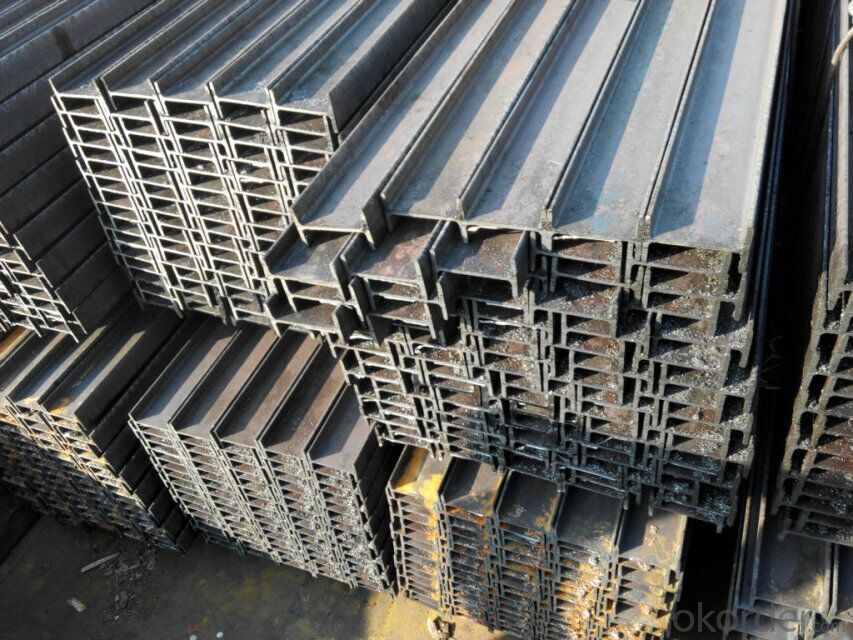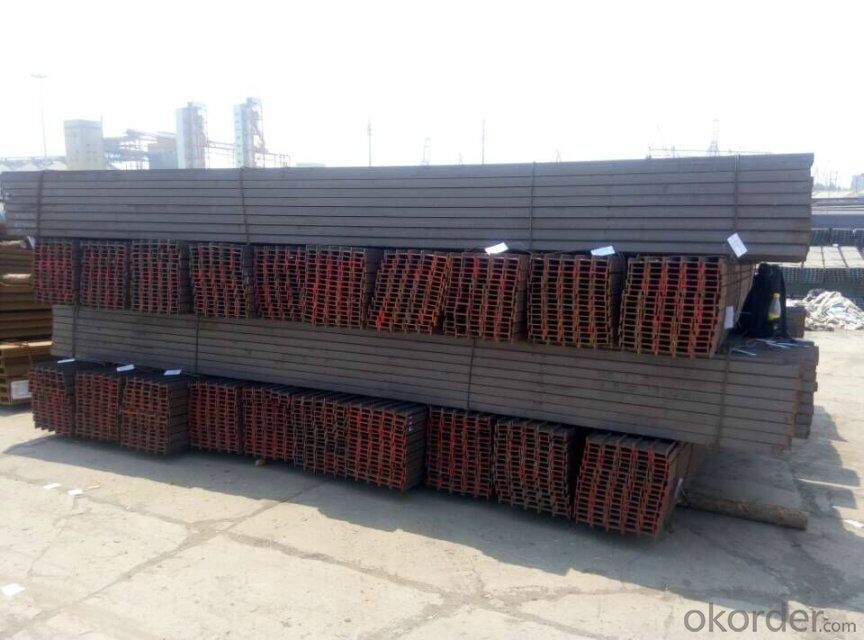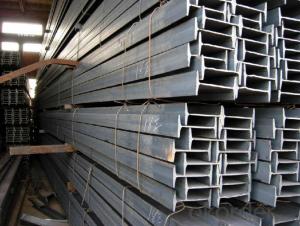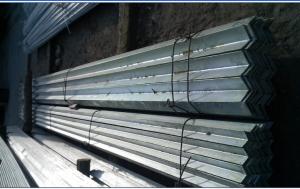Hot Rolled Steel I-Beams Source from China
- Loading Port:
- Tianjin
- Payment Terms:
- TT OR LC
- Min Order Qty:
- 25 m.t
- Supply Capability:
- 10000 m.t/month
OKorder Service Pledge
OKorder Financial Service
You Might Also Like
Item specifice
OKorder is offering high quality Hot Rolled Steel I-Beams at great prices with worldwide shipping. Our supplier is a world-class manufacturer of steel, with our products utilized the world over. OKorder annually supplies products to European, North American and Asian markets. We provide quotations within 24 hours of receiving an inquiry and guarantee competitive prices.
Product Applications:
IPE/IPEAA Beam Steel are widely used in various construction structures, bridges, autos, brackets, mechanisms and so on.
Product Advantages:
OKorder's Steel I-Beams are durable, strong, and resist corrosion.
Main Product Features:
· Premium quality
· Prompt delivery & seaworthy packing (30 days after receiving deposit)
· Corrosion resistance
· Can be recycled and reused
· Mill test certification
· Professional Service
· Competitive pricing
Product Specifications:
1. Product name: IPE/IPEAA Beam Steel
2. Standard: EN10025, GB Standard, ASTM, JIS etc.
3. Grade: Q235B, A36, S235JR, Q345, SS400 or other equivalent.
4. Length: 5.8M, 6M, 9M, 10M, 12M or as your requirements

Section | Standard Sectional Dimensions(mm) | ||||
h | b | s | t | Mass Kg/m | |
IPE80 | 80 | 46 | 3.80 | 5.20 | 6.00 |
IPE100 | 100 | 55 | 4.10 | 5.70 | 8.10 |
IPE120 | 120 | 64 | 4.80 | 6.30 | 10.40 |
IPE140 | 140 | 73 | 4.70 | 6.90 | 12.90 |
IPE160 | 160 | 82 | 5.00 | 7.40 | 15.80 |
IPE180 | 180 | 91 | 5.30 | 8.00 | 18.80 |
IPE200 | 200 | 100 | 5.60 | 8.50 | 22.40 |
IPE220 | 220 | 110 | 5.90 | 9.20 | 26.20 |
IPE240 | 240 | 120 | 6.20 | 9.80 | 30.70 |
IPE270 | 270 | 135 | 6.60 | 10.20 | 36.10 |
IPEAA80 | 80 | 46 | 3.20 | 4.20 | 4.95 |
IPEAA100 | 100 | 55 | 3.60 | 4.50 | 6.72 |
IPEAA120 | 120 | 64 | 3.80 | 4.80 | 8.36 |
IPEAA140 | 140 | 73 | 3.80 | 5.20 | 10.05 |
IPEAA160 | 160 | 82 | 4.00 | 5.60 | 12.31 |
IPEAA180 | 180 | 91 | 4.30 | 6.50 | 15.40 |
IPEAA200 | 200 | 100 | 4.50 | 6.70 | 17.95 |
5.Color marking: There will be color marking on both end of the bundle for the cargo delivered by bulk vessel. That makes it easily to distinguish at the destination port.
Tag mark: there will be tag mark tied up on the bundles. The information usually including supplier logo and name, product name, made in China, shipping marks and other information request by the customer.
If loading by container the marking is not needed, but we will prepare it as customer request.
6. Shipment: In containers or in bulk cargo
FAQ:
Q1: Why buy Materials & Equipment from OKorder.com?
A1: All products are carefully selected from China's most reliable manufacturing enterprises. Through its ISO certifications, OKorder.com adheres to the highest standards and a commitment to supply chain safety and customer satisfaction. We can guarantee the quality!
Q2: The products are invoicing on theoretical weight or on actual weight?
A2: We can do it in both manners, it’s according to buyer's requirement.
Q3: Can you offer the third part inspection certificates ?
A3: Yes, we can apply third part inspection before shipping, such as SGS, BV, etc .
Images:


- Q:What are the common steel finishes for I-beams?
- There are several common steel finishes for I-beams, each serving a specific purpose and offering unique benefits. The most common finishes include: 1. Mill finish: This is the basic finish that steel beams have when they come directly from the mill. It is a raw, untreated surface with a dark gray color. Mill finish is often preferred for its cost-effectiveness and versatility, as it can be easily painted or coated for additional protection against corrosion. 2. Hot-dip galvanized: This finish involves immersing the I-beams in a bath of molten zinc, creating a protective coating on the steel surface. Hot-dip galvanizing provides excellent corrosion resistance, making it ideal for outdoor applications where the beams are exposed to moisture, humidity, and harsh weather conditions. 3. Primed: Priming involves applying a layer of primer paint to the surface of the steel beams. This finish provides a protective barrier against corrosion and prepares the surface for additional coats of paint. Primed I-beams are commonly used in construction projects where the desired color and appearance are important. 4. Powder coated: Powder coating is a process that involves applying a dry powder paint to the surface of the steel beams. The beams are then heated, causing the powder to melt and form a durable, smooth finish. Powder coating offers excellent resistance to chipping, scratching, and fading, making it suitable for both indoor and outdoor applications. 5. Stainless steel finish: I-beams made from stainless steel have a natural, glossy finish that is highly resistant to corrosion and staining. Stainless steel beams are commonly used in environments where hygiene, cleanliness, and resistance to chemical exposure are crucial, such as food processing plants, hospitals, and laboratories. These are some of the most common steel finishes for I-beams, and the choice of finish depends on factors such as the intended application, environmental conditions, aesthetics, and budget. It is essential to select the appropriate finish to ensure the longevity and performance of the I-beams in their specific usage scenario.
- Q:What is the horizontal spacing between the top and outer side frames?
- Ordinary I-beam, lightweight I-beam has formed the national standard, the common 10# I-beam is equivalent to the Internet I100 (such as 10# also channel equivalent channel (U100) for the implementation of the standards of different countries, which have subtle differences in their specifications)
- Q:How do steel I-beams contribute to the overall stability of a building?
- There are multiple ways in which steel I-beams enhance the stability of a building. First and foremost, I-beams are well-known for their remarkable strength and ability to bear heavy loads. Their distinctive shape allows for an even distribution of weight, minimizing the risk of structural failure. The vertical web of the I-beam offers maximum resistance against bending and buckling, enabling it to support heavy loads and withstand external forces like wind or seismic activity. Additionally, the utilization of steel I-beams in construction permits the creation of longer spans and larger open spaces within a building. This is because I-beams have the capacity to support larger loads without requiring additional columns or supports. The ability to have larger uninterrupted floor areas enhances the building's flexibility and functionality, accommodating different uses and allowing for various design possibilities. Furthermore, steel I-beams contribute to the overall stability of a building by providing structural rigidity. The inherent stiffness of steel, combined with the efficient design of the I-beam, helps to minimize deflection and sway in the building during dynamic events such as strong winds or earthquakes. This guarantees that the building remains stable and can withstand external forces without compromising its structural integrity. Moreover, steel I-beams are highly durable and resistant to corrosion, making them particularly important in areas with high humidity or exposure to harsh weather conditions. This durability ensures that the building's structural elements remain intact over time, reducing the risk of deterioration and ensuring long-term stability. In conclusion, steel I-beams contribute to the overall stability of a building through their exceptional strength, load-bearing capacity, and resistance to bending and buckling. They provide structural rigidity, allow for larger open spaces, and offer durability against corrosion. By incorporating steel I-beams into the construction process, buildings can achieve enhanced stability, safety, and longevity.
- Q:Can steel I-beams be used in curved applications?
- Indeed, curved applications can utilize steel I-beams. Although traditionally limited to straight spans and linear structures, I-beams possess the versatility to be incorporated into curved designs as well. The process of curving steel I-beams involves bending them to the desired radius or curvature, which can be accomplished through a range of techniques like hot or cold bending. Architects and engineers commonly employ curved steel I-beams in both architectural and structural designs, particularly when aiming for curved or arched elements. These beams offer a combination of strength, durability, and the opportunity for innovative and visually appealing designs. Nonetheless, it is crucial to consult with structural engineers and experts to ensure that the curved I-beams meet all necessary load-bearing requirements and structural considerations.
- Q:Can steel I-beams be used in residential remodeling or addition projects?
- Yes, steel I-beams can be used in residential remodeling or addition projects. Steel I-beams are commonly used as structural support beams due to their strength and durability. They can be used to replace load-bearing walls, create open-concept spaces, or support additional floors or additions. Steel I-beams provide excellent support for heavy loads and can span longer distances than traditional wood beams. Additionally, they have a smaller profile compared to wood beams, allowing for more flexibility in design and maximizing the usable space in a residential project. However, it is important to consult with a structural engineer or a professional contractor to ensure that the steel I-beams are properly sized and installed to meet the specific structural requirements of the project.
- Q:Are steel I-beams suitable for supporting rooftop helipads?
- Rooftop helipads can indeed be supported by steel I-beams. Renowned for their strength and ability to bear heavy loads, I-beams are perfectly suited for such structural purposes. Steel, a widely used construction material, boasts high tensile strength and durability, enabling it to withstand the weight and impact associated with helicopter landings and takeoffs. Moreover, steel I-beams can be customized and engineered to meet specific load requirements, ensuring the necessary support for a helipad. The popularity of steel I-beams in supporting rooftop helipads across a range of buildings and structures stems from their versatility and dependable nature.
- Q:What are the typical installation methods for steel I-beams?
- The typical installation methods for steel I-beams involve lifting and positioning the beams into place using cranes or hoists, securing them with bolts or welding, and ensuring proper alignment and support through the use of temporary braces or shoring.
- Q:What are the different fabrication methods for steel I-beams?
- There are several different fabrication methods used for steel I-beams, each with its own advantages and applications. 1. Hot rolling: This is the most common method used to fabricate steel I-beams. In this process, a large steel billet is heated above its recrystallization temperature and then passed through a series of rollers to shape it into the desired I-beam profile. Hot rolling provides excellent structural integrity and produces I-beams with consistent dimensions and mechanical properties. 2. Welding and assembly: Another method involves welding or assembling individual steel plates or sections to create the I-beam shape. This method is often used for custom or specialized applications where the dimensions or properties of the I-beam need to be adjusted. Welding can be done using different techniques such as submerged arc welding or gas metal arc welding, depending on the specific requirements. 3. Cold rolling: In this method, steel strips or plates are passed through a series of rollers at room temperature to gradually shape them into the I-beam profile. Cold rolling is generally used for smaller-sized I-beams or for applications where dimensional accuracy and surface finish are critical. It is also commonly used for stainless steel I-beams. 4. Extrusion: Extrusion is a process used to create complex cross-sectional shapes with a continuous length. In the case of steel I-beams, a heated billet is forced through a die to form the desired I-beam shape. Extrusion is often used for manufacturing lightweight or specialized I-beams with unique profiles. Each fabrication method has its own advantages and considerations, such as cost, production speed, size limitations, and the ability to meet specific design requirements. The choice of fabrication method depends on factors like the desired I-beam size, properties, and application.
- Q:Can Steel I-Beams be used for healthcare facilities like hospitals?
- Certainly! Steel I-Beams have proven to be a viable option for healthcare facilities such as hospitals. These I-Beams are frequently utilized in construction projects due to their exceptional strength and durability. They possess the capability to bear heavy loads and provide structural stability, thereby rendering them suitable for various types of buildings, including healthcare facilities. In the case of hospitals, it is often necessary to have large, open areas to accommodate medical equipment and allow for future renovations. By using Steel I-Beams, long distances can be spanned without the need for excessive vertical support, thereby affording more flexibility in the design of healthcare facilities. Moreover, steel exhibits resistance to fire, pests, and rot, thus making it an exceptionally reliable choice for healthcare establishments that prioritize safety and long-term viability.
- Q:What are the considerations for waterproofing when using steel I-beams?
- When it comes to waterproofing steel I-beams, there are a number of important factors that need to be considered. First and foremost, it is absolutely vital to make sure that the steel beams are properly coated or treated in order to prevent corrosion. Steel is susceptible to rust and degradation when exposed to moisture, so it is crucial to apply a high-quality protective coating or treatment to the surface of the beams. This will help to maintain their structural integrity and prevent water from seeping into the material. Another aspect that needs to be taken into account is the connection points between the steel beams and other structural elements, such as walls or floors. These connection points must be carefully sealed in order to prevent any water from infiltrating. The use of waterproof sealants or gaskets at these junctions can help create a watertight barrier and prevent any potential leaks. Additionally, it is important to ensure that the design and construction of the building incorporate proper drainage systems to redirect water away from the steel beams. This can involve the installation of gutters, downspouts, and appropriate slope in the surrounding landscape to ensure proper water runoff. By effectively managing the flow of water, the risk of water pooling or accumulating around the steel beams is minimized. Furthermore, it is essential to take into consideration the possibility of condensation forming on the steel beams. When warm air comes into contact with cold surfaces, condensation can occur, leading to the build-up of moisture. To prevent this, it is necessary to install proper insulation to maintain a consistent temperature and minimize temperature differences that could cause condensation. Adequate ventilation should also be provided to allow any trapped moisture to escape. Lastly, regular inspection and maintenance are key to ensuring the long-term waterproofing of steel I-beams. Periodic checks should be carried out to identify any signs of water damage, corrosion, or leaks. If any issues are detected, such as the need to reapply coatings, reseal connection points, or address drainage problems, prompt repairs should be undertaken. In conclusion, when waterproofing steel I-beams, it is essential to address the risk of corrosion, seal connection points, manage water drainage, prevent condensation, and conduct regular maintenance. By taking these factors into consideration, the structural integrity of the steel beams can be preserved, ensuring the long-lasting durability of the overall construction.
1. Manufacturer Overview |
|
|---|---|
| Location | |
| Year Established | |
| Annual Output Value | |
| Main Markets | |
| Company Certifications | |
2. Manufacturer Certificates |
|
|---|---|
| a) Certification Name | |
| Range | |
| Reference | |
| Validity Period | |
3. Manufacturer Capability |
|
|---|---|
| a)Trade Capacity | |
| Nearest Port | |
| Export Percentage | |
| No.of Employees in Trade Department | |
| Language Spoken: | |
| b)Factory Information | |
| Factory Size: | |
| No. of Production Lines | |
| Contract Manufacturing | |
| Product Price Range | |
Send your message to us
Hot Rolled Steel I-Beams Source from China
- Loading Port:
- Tianjin
- Payment Terms:
- TT OR LC
- Min Order Qty:
- 25 m.t
- Supply Capability:
- 10000 m.t/month
OKorder Service Pledge
OKorder Financial Service
Similar products
New products
Hot products
Related keywords



























